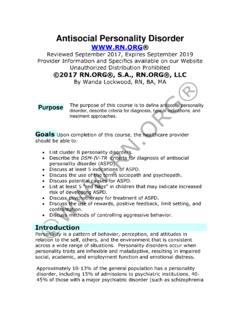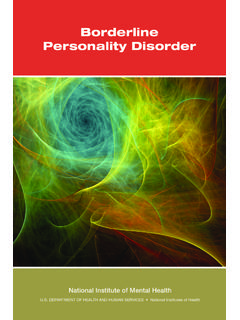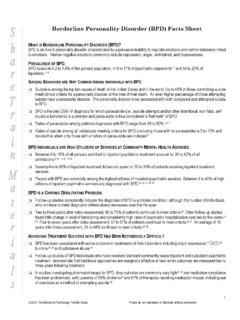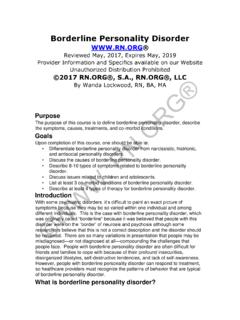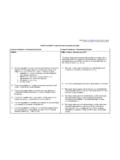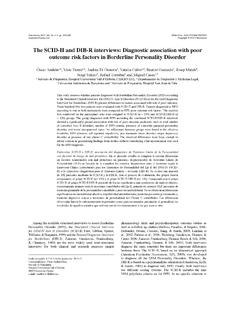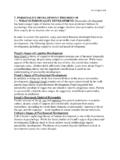Transcription of 8 Personality disorders and substance use
1 58 | 8 Personality disorders and substance Personality disordersA Personality disorder is an enduring pattern of inner experience, of seeing the world and relating to others in a manner that markedly deviates from cultural expectations, and includes, and results in, problematic and habitual behaviours that are pervasive and inflexible. The onset of Personality disorders occurs in adolescence or early adulthood, is stable over time, leads to impairment or distress and is not due to mental disorder or substance disorders are long-standing and maladaptive patterns of perceiving and responding to other people and to stressful traits are conspicuous features of Personality and are not necessarily pathological, although certain styles of Personality traits may cause interpersonal problems. Personality disorders are not regarded as illnesses. However, some dominant Personality traits and Personality disorders can be modified and some managed on a systemic Personality disorder subtypesCluster A Personality disorderIncludes paranoid, schizoid and schizotypal types.
2 Individuals display odd and eccentric behaviour. ParanoidPerson displays patterns of distrust and suspiciousness such that others motives are interpreted as displays a pattern of detachment from social relationships and a restricted range of emotional displays a pattern of acute discomfort in close relationships, cognitive or perceptual distortions, and eccentricities of behaviour. | 59 Personality disorders and substance use Chapter 8 Cluster B Personality disorderIncludes antisocial , borderline, histrionic and narcissistic types. Individuals display dramatic, erratic and emotional displays a pattern of disregard for, and violation of, the rights of displays patterns of instability in interpersonal relationships, self image and effects as well as marked displays patterns of excessive emotionality and attention-seeking displays patterns of grandiosity, need for admiration and lack of C Personality disorderIncludes avoidant, dependent and obsessive compulsive types.
3 Individuals display anxious and fearful displays patterns of social inhibition, feelings of inadequacy and hypersensitivity to negative displays patterns of submissive and clinging behaviour relating to the excessive need to be taken care compulsivePerson displays patterns of preoccupation with orderliness, perfectionism and disorders not otherwise specifiedPersonality disorders not otherwise specified are those where: The individual s Personality pattern meets the general criteria for a Personality disorder and traits of several different Personality disorders are present, but the criteria for any specific Personality disorder are not met. The individual s Personality pattern meets the general criteria for a Personality disorder, but the individual is considered to have a Personality disorder that is not included in the | Of all the different types of Personality disorders , Cluster B Personality disorders (including narcissistic, histrionic, borderline and antisocial ) come to the attention of health providers and authorities the most.
4 People with antisocial Personality disorders frequently end up in the criminal justice system(312, 313). Management approaches Limit setting and the use of therapeutic contracts are extremely important in this client group. It is important that clinicians remain vigilant when dealing with people who have Personality disorders in order to avoid being manipulated. There is no specific pharmacological treatment for Personality disorders . Personality disorders are not normally an indication for medication which adds to their management remaining controversial. A variety of medications have been reviewed for some types of behaviours associated with Personality disorders such as impulsivity and aggression. However, good quality data relating to efficacy is limited. Antidepressants and mood-stabilising drugs such as carbamazepine, lithium, sodium valproate and other SSRIs are among those that have been studied.
5 They do not provide a cure, but have assisted with some symptom control for some Cluster B Personality traits**(314, 315). Scheduling of brief, structured and frequent visits to primary care providers is recommended. Restriction of access to emergency services and last minute appointments may be helpful in the management of Personality disorders (316). A balance must be ensured between the fostering of dependency and providing the support and crisis intervention that is required. Early case management with other primary care providers (emergency department staff, locum services, after hours staff, emergency services and mental health staff ) is Comorbidity with Personality disordersPeople with Personality disorders have: High rates of additional mental disorders (317). Higher rates of psychotic symptoms and psychotic disorders than controls and those with other mental disorders (316). Significant psychosocial impairment(312, 316).
6 Higher rates of impulsivity compared with those who do not have a Personality disorder(312, 316). Higher rates of suicidal ideation and suicidal behaviour than the general population(312, 316). substance use is common in people with Personality disorders (120, 312, 317-319).The term borderline was first used to capture the features of the Personality disorder that is borderline between psychosis and neurosis and characterised by extremes of mood and use is most common in those with Cluster B type Personality disorder, in particular, borderline and antisocial Personality disorder(120, 313, 318-320). | 61 Cannabis/ hallucinogensPersonality disorders and substance use Chapter 8 Conduct disorder in childhood (a necessary prerequisite to conclude that an adult has an antisocial Personality disorder) is predictive of substance -use disorders between adolescence and early adulthood(320).People with comorbid Personality disorder and substance use: Have more problematic symptoms of substance use than those without a Personality disorder(320).
7 Are more likely to participate in risky substance -injecting practices that predispose them to blood borne viruses(312). Are more likely to engage in risky sexual practices(312) and other disinhibited behaviours. May have difficulty staying in treatment programs and complying with treatment plans(312, 316).Treatment for substance use in people with Personality disorders is associated with a reduction in substance use(313).Treatment for substance use is also associated with a reduction in the likelihood of being arrested(313), suggesting a reduction in criminal General management approaches to comorbidity People with Personality disorders are difficult to manage. Often, the underlying disorders will only become apparent after previous attempts to treat comorbidities have failed. People with Personality disorders should be counselled about substance use and the problems that arise from substance use, given their particular personalities.
8 However, many clients have difficulty even recognising that their substance use is Major clinical issues with Personality disorders and cannabis/hallucinogen use People with Personality disorders display more symptoms of cannabis use disorders than those who do not have a Personality disorder. Advice regarding cannabis usage in these disorders depends on the degree of dysfunction associated with use. In the absence of other proven forms of treatment, CBT is, at present, the most widely-employed form of treatment for cannabis use. Effects of cannabis and other hallucinogens on Personality disorders Conduct disorder in adolescence increases the risk of initiating marijuana use(320). Age of first use of cannabis is earlier in people with Personality disorders compared to whose without Personality disorders (320).62 | People with Personality disorders display more symptoms of cannabis dependence than those who do not have a Personality disorder(320).
9 Symptoms associated with cannabis dependence increase over time in those with Personality disorders (320). Interactions between cannabis and other hallucinogens and therapeutic agents for Personality disorders Cannabis can exacerbate the sedative effects of carbamazepine, lithium and sodium valproate . Cannabis can exacerbate the sedative effects of antidepressants such as tricyclics . LSD may induce a serotonin syndrome (Appendix 1); therefore, caution should be exercised when prescribing SSRIs or MAO-I (127). Cannabis and antidepressants are metabolised by CYP 450 enzymes which may result in the inhibition or induction of either drug group. Therefore, individuals should be monitored closely to ensure outcomes are appropriate . Management approaches to comorbid Personality disorders and cannabis use Advice regarding cannabis use for people with these disorders depends on the degree of dysfunction associated with use.
10 Overall approach depends on the person s readiness for change. Abstinence from cannabis is a difficult goal to achieve in cannabis dependent people(128). In the absence of other proven forms of treatment, CBT is, at present, the most widely-employed form of treatment for cannabis use**(128). Major clinical issues with Personality disorders and alcohol use Personality disorders (in particular antisocial and borderline) and alcohol use disorders frequently co-exist. Alcohol can exacerbate the sedative effects of some antidepressants such as tricyclics and mirtazepine. Alcohol can exacerbate the sedative effects of carbamazepine, lithium, and sodium valproate. Acamprosate or naltrexone can be considered for long-term abstinence with naltrexone showing effectiveness in moderating drinking in those with antisocial Personality Effects of alcohol on Personality disorders Personality disorders (in particular antisocial and borderline) and alcohol use disorders frequently co-exist(16, 120, 317, 319-322).

